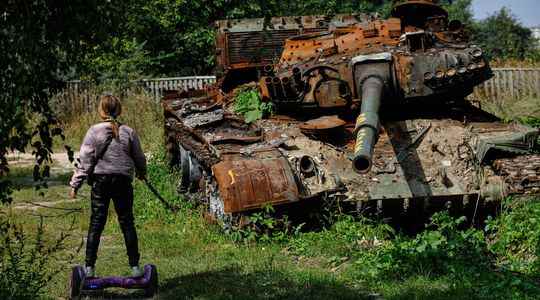The efforts of the Ukrainian army, launched in a counter-offensive for a week, seem to be paying off on the ground. President Volodymyr Zelensky announced on the evening of Thursday, September 8, that his troops had broken through the Russian defenses on the northeastern and southern fronts, and in particular recaptured the town of Balaklia, in the Kharkiv region. During the day, US Secretary of State Antony Blinken, on a surprise visit to kyiv, announced new military aid of $2.8 billion for Ukraine and 18 countries in the region.
- Kyiv claims breakthroughs in northeast and south
In his daily webcast, Volodymyr Zelensky said his forces had recaptured the town of Balaklia, in the eastern Kharkiv region, from the Russian army and had broken through the Russian defenses until 50 kilometers deep. “Things are as they should be. The Ukrainian flag flies over a liberated Ukrainian city, under the sky of Ukraine”, published the president, also posting a video where Ukrainian soldiers march in this city of 27,000 inhabitants conquered by the Russian army at the beginning of March.
Ukrainian troops have been carrying out a counter-offensive since last week, in particular to retake the occupied region of Kherson, in the south. In this part of the country, kyiv says it has pierced “deeply”, up to “several tens of kilometers”, the Russian lines and “liberated several localities”, according to Oleksiï Gromov, a senior official of the Ukrainian staff.
In the Donbass, the eastern mining basin where the heaviest fighting of the war has taken place in recent months, the Ukrainian military authorities claim to have advanced two to three kilometers near Kramatorsk and Sloviansk, and recaptured the village of ‘Ozerne. These gains, which cannot be independently verified immediately, would be the most significant for Ukraine since the withdrawal of Russian troops from around kyiv in late March.
- Visiting kyiv, Antony Blinken announces $2.8 billion in military aid
These announcements were made the day of the surprise visit to kyiv of Antony Blinken, the head of American diplomacy. “It’s still very early, but we see clear and real progress on the ground, especially in the area around Kherson but also interesting developments in the east in the Donbass”, commented the diplomat. The progress of the Ukrainian counter-offensive is “regular”, also welcomed the American Chief of Staff, Mark Milley.
Antony Blinken, who is making his second visit to kyiv since the start of the war, came with the promise of a new tranche of aid of 2.8 billion dollars for Ukraine and 18 countries in the region. Of this sum, 675 million will go directly to kyiv in the form of deliveries of armaments, ammunition and HIMARS artillery systems, which have already enabled kyiv to hit Russian supply lines. The remaining 2.2 billion will be disbursed as loans and subsidies to Ukraine as well as to countries feeling threatened by Russia, for the purchase of American arms. This new tranche sets the total amount of American aid since the start of the invasion at $15.2 billion.
- Ukraine buys second-hand guns from a French company
Ukraine has purchased an unspecified number of TRF1 towed guns from a French company specializing in military opportunities to support the intense artillery combat against Russian forces, the Cabinet of the French Minister of the Armed Forces, confirming information from L’Opinion. Like any sale of armaments, the transaction carried out by the company S2M Equipment has been approved by the French government through the Interministerial Commission for the Study of War Material Exports (CIEEMG).
The TRF1 is a towed gun with a caliber of 155 mm, capable of firing shells at 25 kilometers. The French army, which used it from the 1980s to the 2010s, had 106 examples of this gun. It is still in service in Cyprus and Senegal, according to Military Balance. Paris remains discreet about its arms deliveries to Ukraine, acknowledging at most having delivered “more than 160 million euros” of equipment to kyiv, in particular 18 Caesar self-propelled guns, which succeeded the TRF1 within the French army.
- Warsaw and the Baltic countries will restrict the entry of Russian nationals
Poland and the three Baltic States announced on Thursday that they had agreed to temporarily restrict the entry on their soil, from September 19, of Russian citizens holding European visas. The Prime Ministers of Poland, Lithuania, Latvia and Estonia express in a statement their concern “at the large and growing influx of Russian nationals into the EU”. “We believe this is becoming a serious threat to our public security and to the entire Schengen area,” they add.
The four countries indicate that they have agreed on “a common regional approach” aimed at “introducing temporary national measures for Russian citizens holding visas”. These measures “will restrict entry into the Schengen zone for Russian citizens traveling for tourist, cultural, sporting or professional reasons”. Exceptions will be made for different categories, including “dissidents”, “humanitarian cases”, family reasons and holders of residence permits in the European Union.
EU foreign ministers decided last week in Prague to suspend a visa facilitation deal with Russia. However, they had not validated a broader visa ban, as requested by Poland and the Baltics. The head of European diplomacy Josep Borrell had however declared that the countries bordering Russia “can take measures at the national level to restrict entry into the European Union”. He specified that these measures should comply with the rules of the Schengen area and underlined the importance of members of Russian civil society being able to continue to travel to the European Union.
